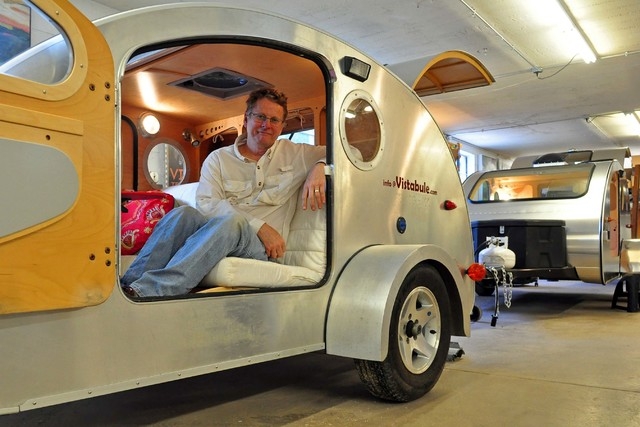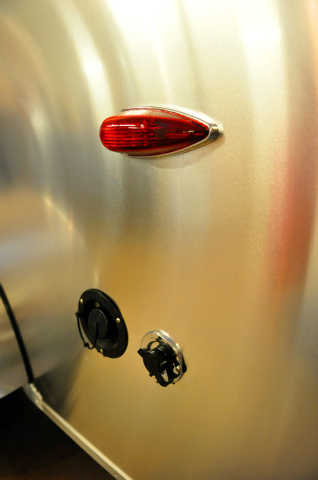Vistabule is new take on vintage camper trailer
MINNEAPOLIS — Several years ago, a friend told Minneapolis furniture designer Bert Taylor he should look up “teardrop campers” on the Internet.
It changed his life.
“This was a scale I could work with,” Taylor, 63, said. “These were basically the size of large pieces of furniture.”
Today, Taylor and a small staff build sleek, compact, retro-style camper trailers from a workshop in Minneapolis’ warehouse district.
His 3-year-old enterprise, Vistabule, is modest but growing; he built 12 campers last year and this year, his goal is 36.
Vistabule is a portmanteau word combining vista — drawn from the signature gaping window that affords its occupants ample views — and vestibule, suggestive of the cozy confines of the 5-foot-by-10-foot trailers.
“I wanted to take the cave on wheels and turn it into an observatory on wheels,” he told the St. Paul Pioneer Press (http://bit.ly/V3oqup ) while showing a reporter around his workshop.
The place smells of a woodworking shop — sawdust from the blonde-hued Baltic birch that forms the interior paneling of the campers. The workforce on this day consists of his brother Dave, 67, and friend and partner Don Grandbois, 77. The average age is reduced by Bert Taylor’s daughter Lilly, 26, who works the computer.
The atmosphere is relaxed and joking. Two containers of Franzia boxed wine are perched on a cabinet, ready for dispensing. Among Taylor’s numerous endeavors over the years, he’s also taking a stab at growing vineyards.
“I started this venture late in life,” he chuckled. “I didn’t really realize how much effort this would take, mentally and physically, but I feel lucky to be doing it. And I love solving design problems.”
Originally, Taylor had been interested in campers for two reasons. He wanted to buy one because he appreciated the design of vintage models like Airstream and he figured as he aged he’d appreciate a camper more than a tent. The second was that he wanted inspiration for designing furniture.
When that friend told him to research teardrop campers — small trailers that offer a place to sleep out of the elements but don’t attempt to offer living rooms, showers and other amenities of full-size recreational vehicles—- it inspired him to try to build one himself. For fun. “We don’t see ourselves as RVers, but as campers.”
He purchased plans and started to build one, but his propensity for design improvement got in the way.
“I realized this was the work of an amateur,” he said. “It might have been good for the trailer he wanted, but not for the one I wanted. It was claustrophobic. I knew I could do better.”
The creation he eventually built in 2011 was a head-turner. When asked to described the genre, he uses word like “iconic,” ”from the 1930s and ’40s,” ”nautical” and “vintage UFO.”
“We took it to the Grand Canyon, and the response we got was unbelievable,” he said. “Everyone wanted to talk to us and look inside.”
Teardrop trailers are a niche at the tiny end of the camper trailer continuum. But they have a devoted following. The premise is a level of comfort, but a compactness that makes for storage in any garage and lightness that can handle being towed by most cars. (Vistabules are lighter than 1,300 pounds, within the threshold for many sedans.)
One small maker of retro-style aluminum-skinned models is Necedah, Wisconsin-based Camp-Inn. Big Woody Campers builds wood-paneled versions out of Elk Mound, Wisconsin. The big guy on the block is Little Guy, based in Ohio.
Little Guy offers campers starting as low as $4,400. Vistabules, on the other hand, generally range from $14,000 to $17,000.
The difference in price was well worth it for Stephanie Weiss of West St. Paul. In the summer of 2012, she was in the market for a teardrop camper. “Every time I camped, it seemed like I was always waking up in a puddle of water,” said Weiss, 47, the director of news and media services at Augsburg College. “As I got older, I just wanted to be more comfortable.”
She stumbled across Taylor’s ad on Craigslist just hours, it turned out, after he had first posted it — his first attempt to sell a Vistabule.
“I told him I wanted to hire him to build me one,” she said. “I think he thought I was crazy.”
What sold Weiss, who has a history in sailing, was the nautical theme, the relative roominess and, of course, that huge picture window — an element perhaps unique to the Vistabule.
As for the cost: “If you give a rip about aesthetics, it’s absolutely worth it,” she said. “You get something so beautiful. If you want to sleep in a Clorox bottle, go buy a fiberglass one.”
Weiss’ enthusiasm for her camper is unequivocal. From the ease of trailering and backing into campsites — the large windows allow the driver to see right through the thing — to the functionality of the kitchenette, or “galley,” she said it’s become an integral part of summer travel for her, her fiance and their dogs.
“I will hook it up Friday evening or Saturday morning, and if the sweetheart can’t go with me, I grab a dog and just go,” she said. After-dark setup involves little hassle, unlike a tent, and the purchase has allowed her to start working through a bucket list of state parks within a couple hours’ drive of the Twin Cities. Family events and weather have cramped her camping so far this season, but she said it’s often substituted for a motel or fold-out sofa at family functions, affording her solitude and a view.
And she draws a crowd. “You can’t be an introvert and own one because everyone wants to talk to you about it.”
Taylor said he’s constantly tinkering with improving the design and functionality. Door and window latches, for example, are custom made. “I didn’t design it for off-the-shelf parts,” he said. “That would limit me too much.”
As for the basic shape, the curves and the feel, he believes he accomplished what he set out to do.
“It was difficult to come up with something unique, but I think I’ve done it.”
———
Online:
Vistabule: http://www.Vistabule.com
———
Information from: St. Paul Pioneer Press, http://www.twincities.com
An AP Member Exchange Feature shared by St. Paul Pioneer Press
























